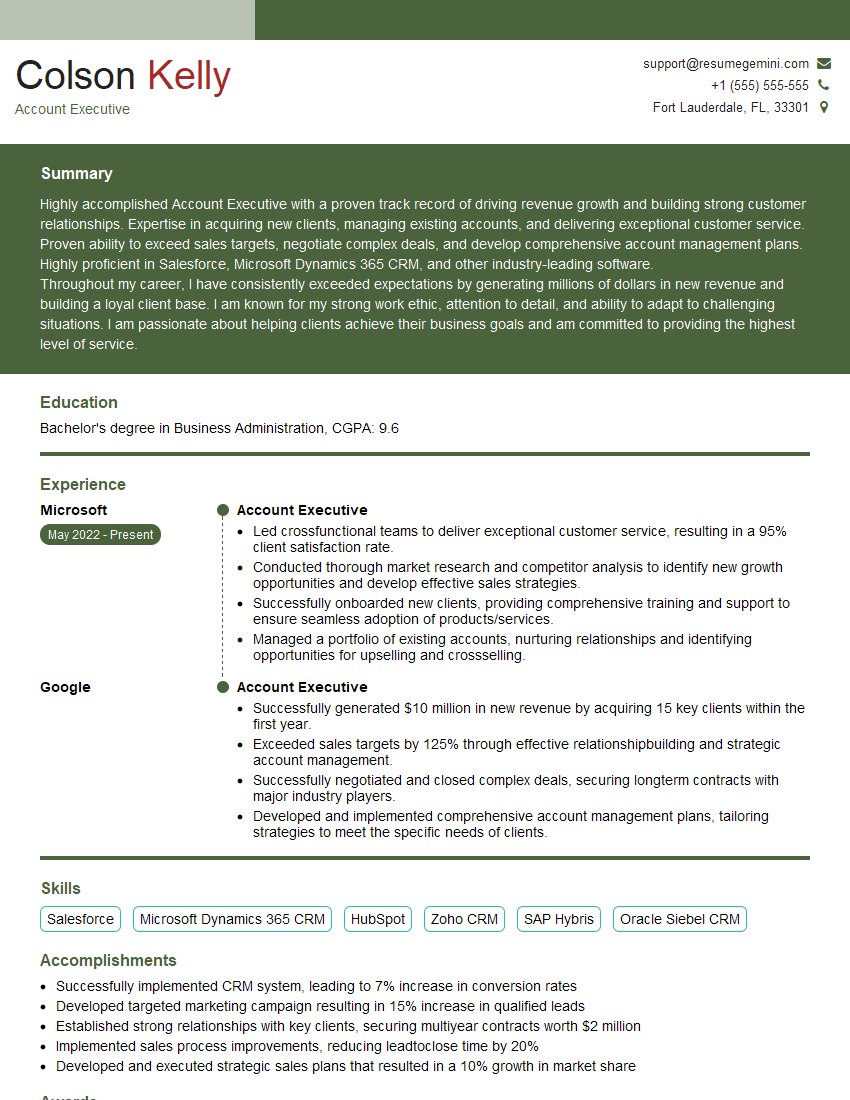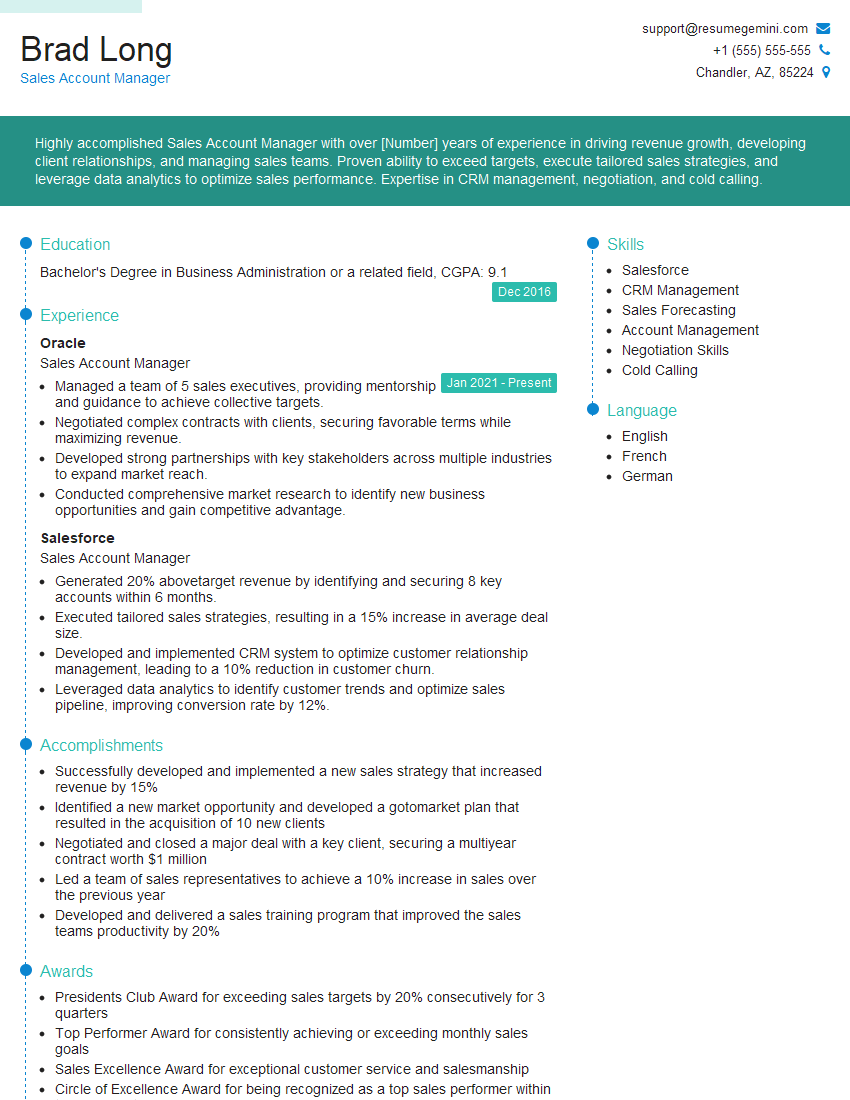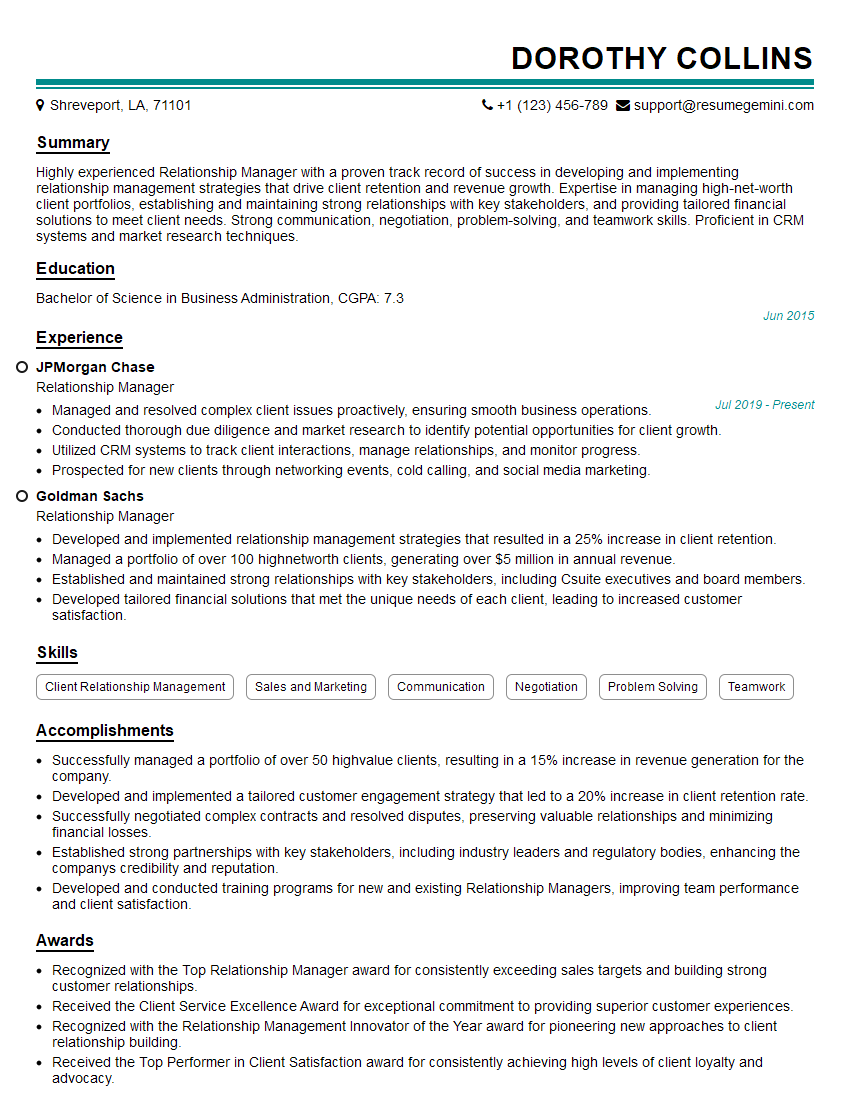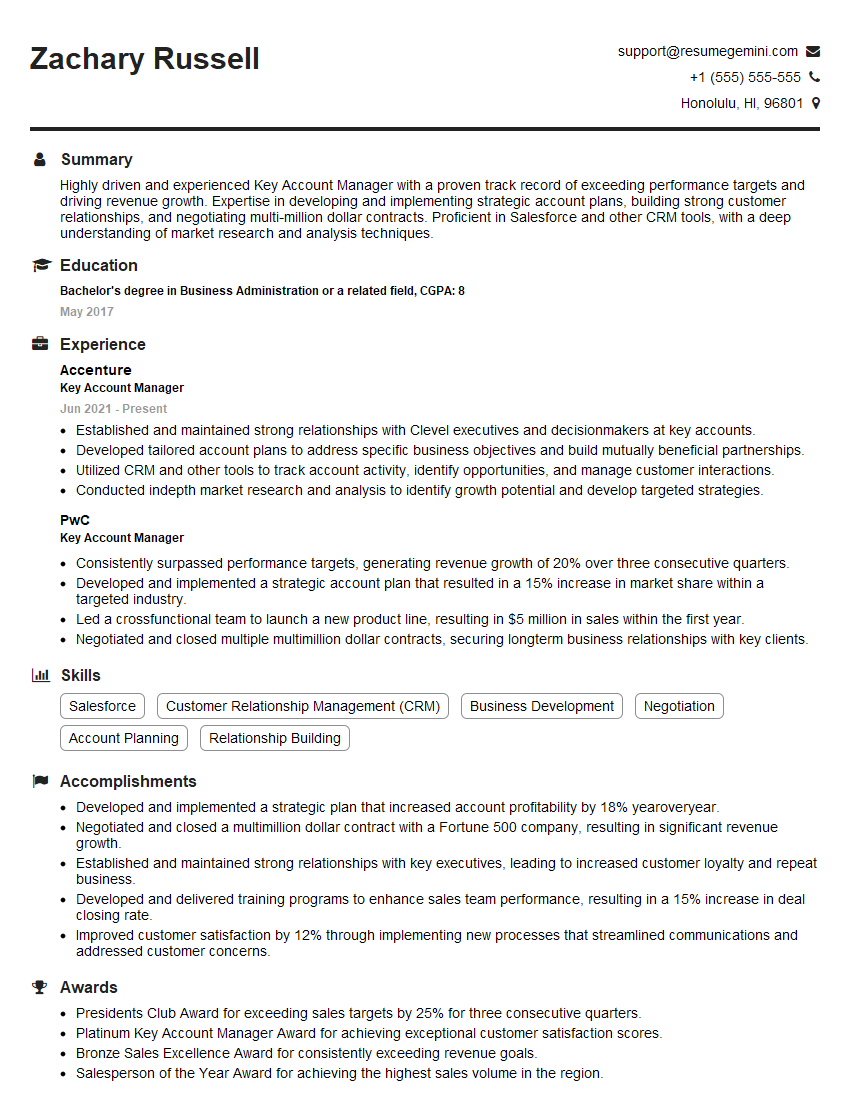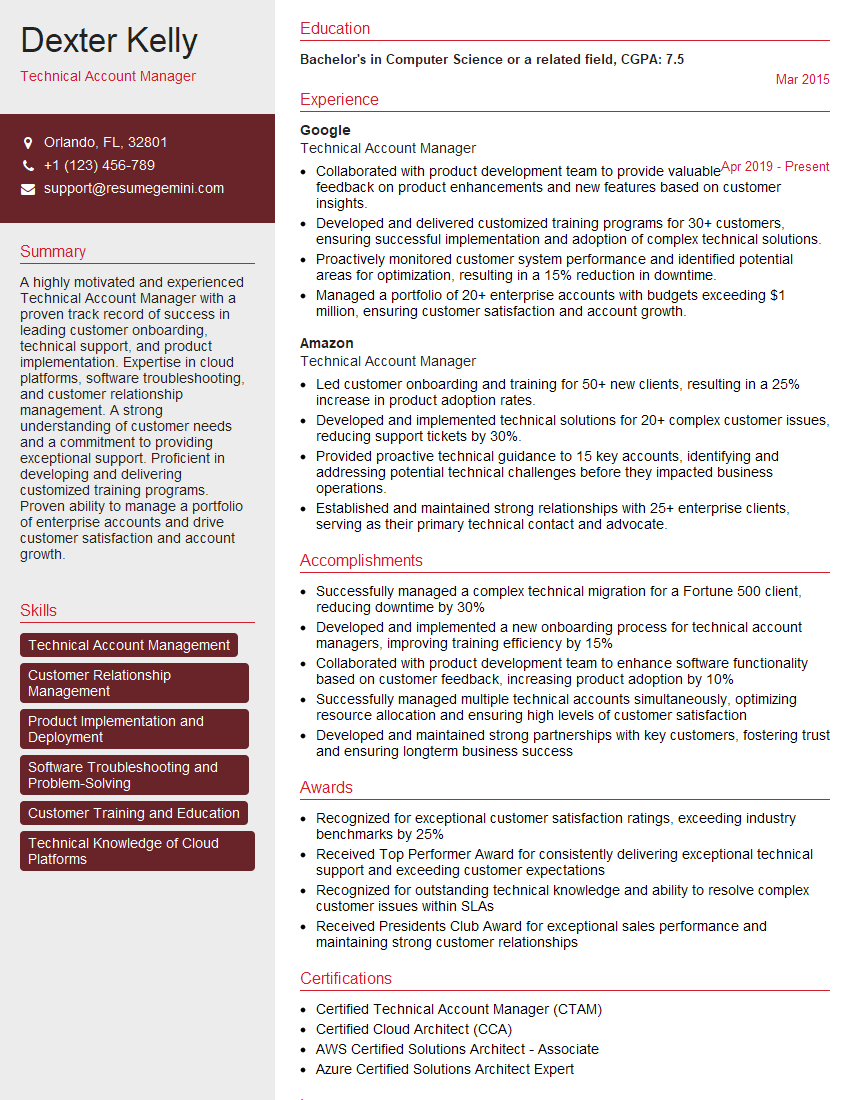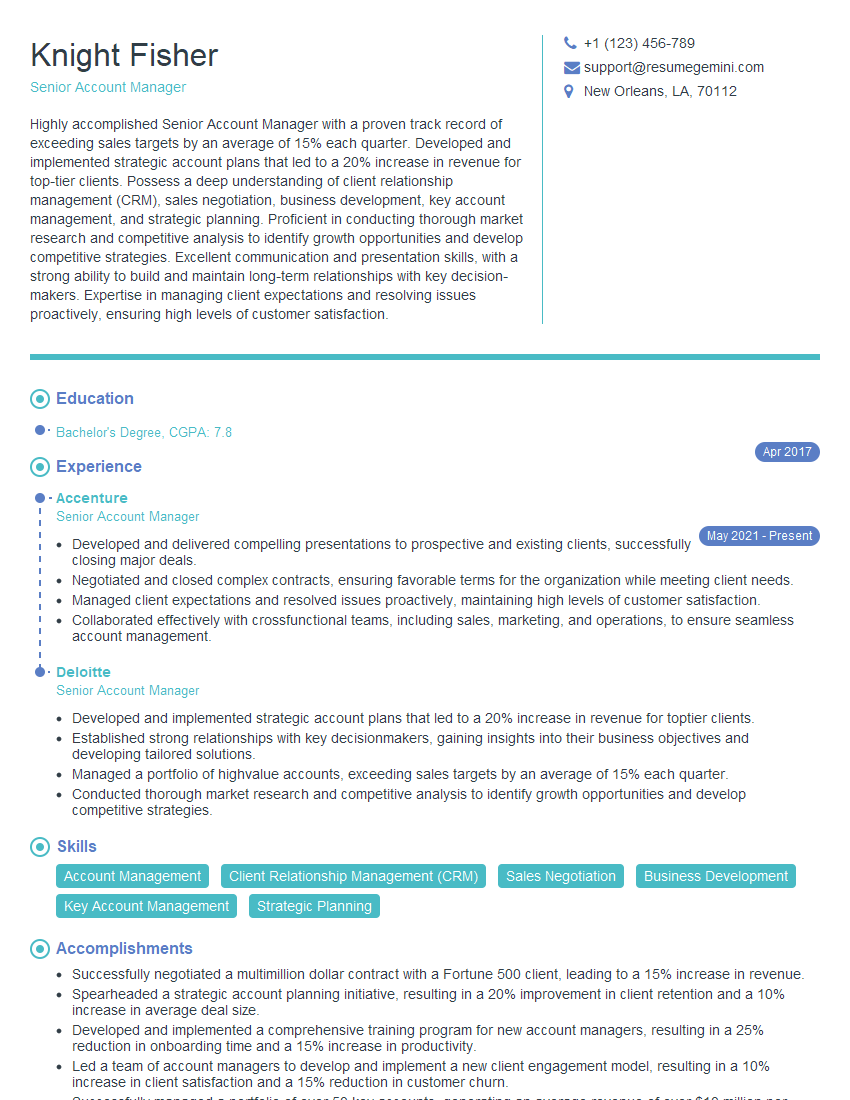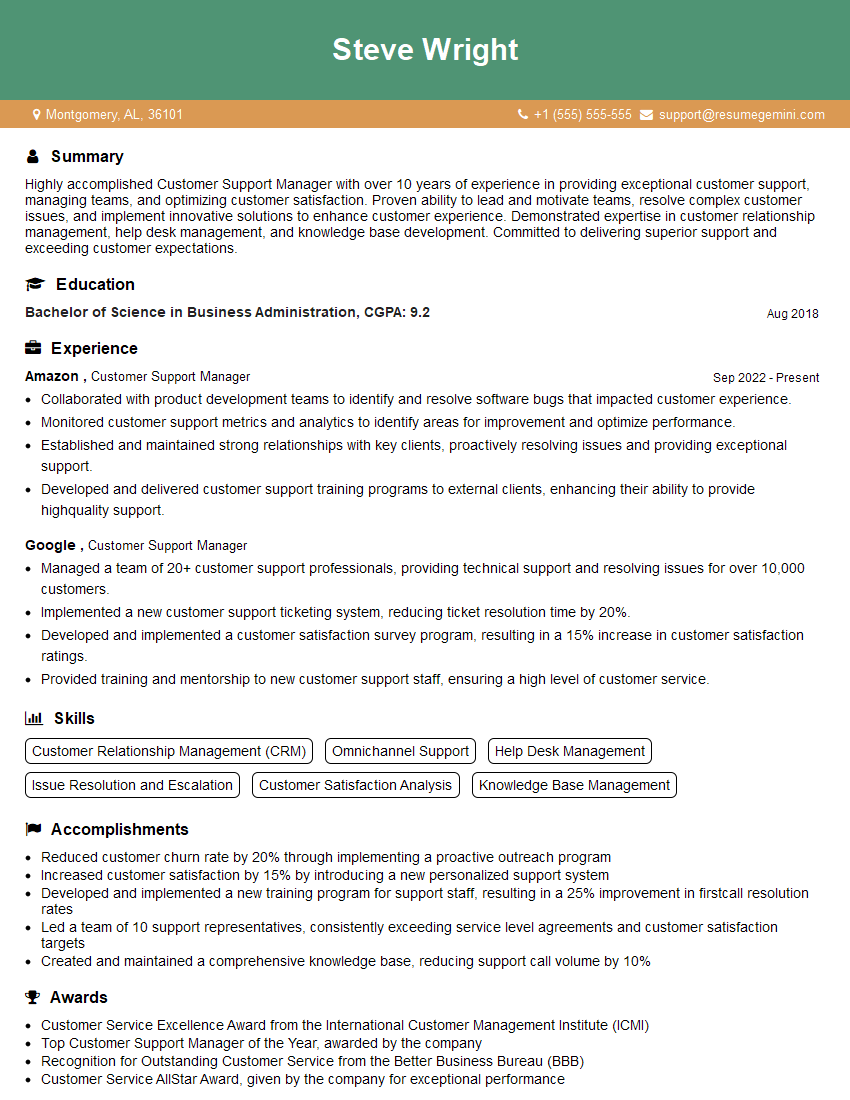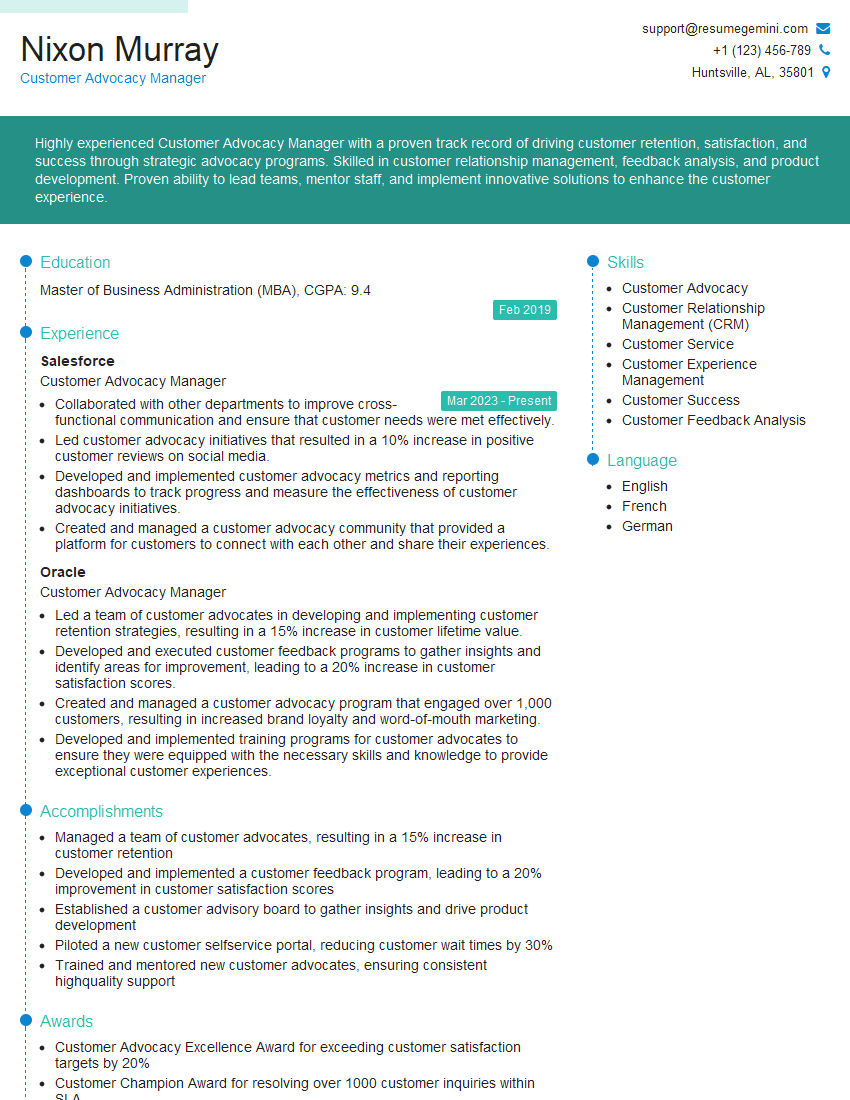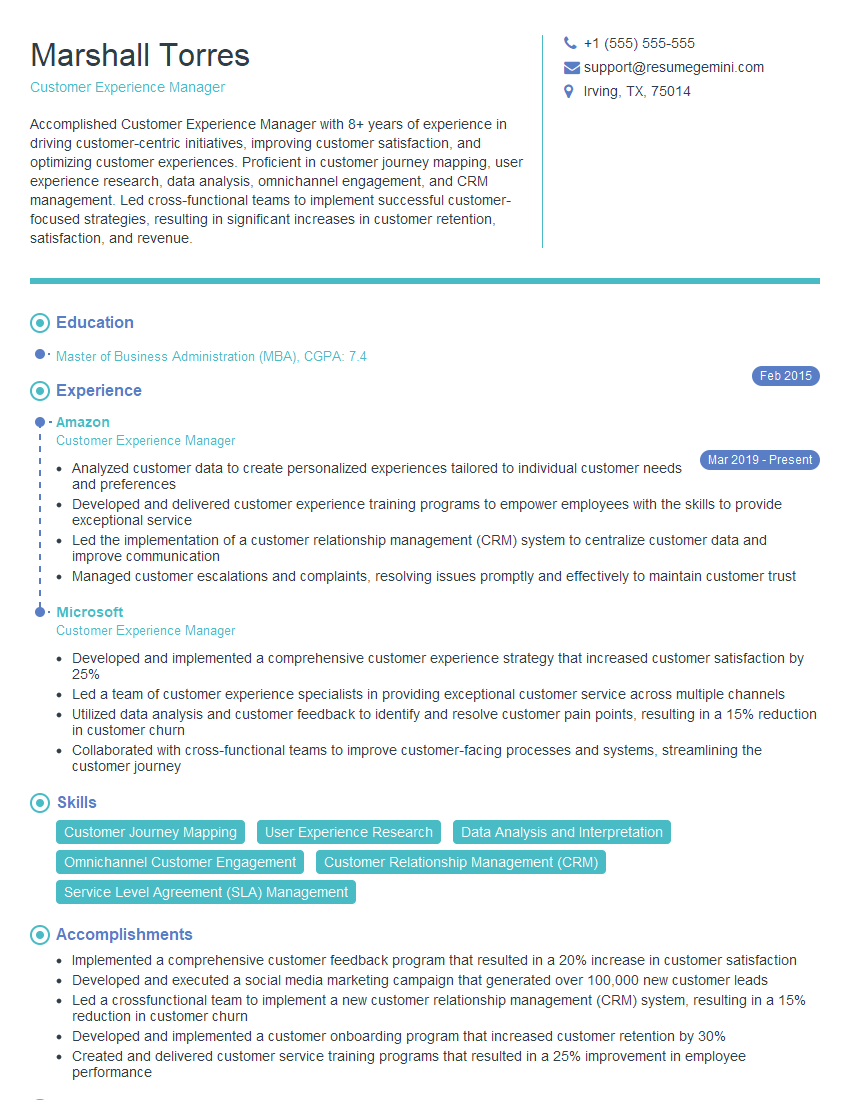The right preparation can turn an interview into an opportunity to showcase your expertise. This guide to Certified Customer Relationship Professional (CCRP) interview questions is your ultimate resource, providing key insights and tips to help you ace your responses and stand out as a top candidate.
Questions Asked in Certified Customer Relationship Professional (CCRP) Interview
Q 1. Explain the core principles of customer relationship management (CRM).
Customer Relationship Management (CRM) is a holistic approach to managing a company’s interactions with current and potential customers. At its core, CRM focuses on improving business relationships to grow the business. It’s not just about software; it’s a philosophy. The core principles revolve around:
- Customer-centricity: Placing the customer at the heart of every decision, understanding their needs, and tailoring experiences to meet those needs. Imagine a coffee shop that remembers your regular order – that’s customer-centricity in action.
- Data-driven decision making: Using data collected about customer interactions to inform strategies and improve customer service. This means analyzing sales data, customer feedback, and website analytics to pinpoint areas for improvement.
- Improved communication and collaboration: Ensuring seamless communication across all departments – sales, marketing, customer service – to provide a consistent and positive customer experience. For instance, if a customer contacts support, that information should be readily available to the sales team for future interactions.
- Increased customer loyalty and retention: Building strong, lasting relationships with customers leads to repeat business and positive word-of-mouth referrals. This is achieved through personalized interactions and excellent service.
- Automation and efficiency: Leveraging technology to streamline processes, automate tasks, and free up human resources to focus on more strategic activities. Think automated email responses, appointment scheduling, or lead nurturing campaigns.
Q 2. Describe your experience with different CRM software platforms (e.g., Salesforce, HubSpot).
I’ve had extensive experience with several CRM platforms, most notably Salesforce and HubSpot. My experience with Salesforce involved managing large-scale deployments, customizing workflows, and developing reports to track key performance indicators (KPIs). I worked on complex configurations for lead management, sales forecasting, and opportunity tracking, optimizing the system for our sales team’s efficiency. We integrated it with our marketing automation platform for a seamless customer journey. With HubSpot, I focused more on marketing automation and inbound strategies. I leveraged its capabilities to create automated email sequences, landing pages, and content workflows. I used A/B testing to continuously refine our marketing efforts and track the effectiveness of different campaigns. The difference lies in Salesforce’s more sales-focused approach and HubSpot’s more marketing-centric features, although both offer robust functionalities that overlap.
Q 3. How do you identify and prioritize customer needs?
Identifying and prioritizing customer needs involves a multi-faceted approach. I begin by actively listening to customers through various channels: surveys, feedback forms, social media monitoring, and direct customer interactions. Analyzing this qualitative data is crucial. Then, I delve into quantitative data from the CRM system itself. This might include purchase history, website activity, support tickets, and engagement levels. By cross-referencing qualitative and quantitative insights, I can identify patterns and trends in customer needs and preferences. Prioritization is based on several factors, including the urgency of the need, the potential impact on customer satisfaction, and the feasibility of addressing the need. I often use a prioritization matrix – ranking needs based on impact and effort – to make informed decisions.
Q 4. What strategies do you employ to build strong customer relationships?
Building strong customer relationships requires a commitment to personalized experiences and proactive engagement. My strategies include:
- Personalized communication: Tailoring messages and offers to individual customer preferences and needs. This includes using their name, referencing past interactions, and offering relevant recommendations.
- Proactive service: Anticipating customer needs and addressing potential issues before they arise. For example, sending proactive email reminders or offering support resources.
- Building trust and rapport: Establishing genuine connections with customers through empathy, understanding, and consistent follow-up. This often involves acknowledging their concerns and taking ownership of resolving their issues.
- Loyalty programs and rewards: Recognizing and rewarding valuable customers through loyalty programs that offer exclusive benefits and discounts.
- Regular feedback and follow-up: Actively seeking feedback from customers and consistently following up to address their concerns and show that their input is valued.
Q 5. Describe your approach to managing challenging customer interactions.
Managing challenging customer interactions requires patience, empathy, and a structured approach. My approach involves:
- Active listening: Carefully listening to the customer’s concerns without interrupting or becoming defensive.
- Empathy and understanding: Attempting to understand the customer’s perspective and acknowledging their frustration.
- Clear and concise communication: Explaining the situation clearly and concisely, avoiding jargon or technical terms.
- Taking ownership and responsibility: Taking ownership of the issue and committing to finding a resolution.
- Offering solutions and alternatives: Exploring various solutions and offering alternatives to address the customer’s needs.
- Escalation when necessary: Knowing when to escalate the issue to a supervisor or manager if a resolution cannot be reached.
- Following up: Following up with the customer after the issue has been resolved to ensure their satisfaction.
Even in the most difficult situations, maintaining a calm and professional demeanor is paramount. Remember, the goal is to de-escalate the situation and find a mutually acceptable resolution.
Q 6. How do you measure the success of your customer relationship efforts?
Measuring the success of customer relationship efforts involves tracking several key metrics. These can be broadly categorized into:
- Customer Satisfaction (CSAT): Measured through surveys and feedback forms. A high CSAT score indicates positive customer experiences.
- Net Promoter Score (NPS): Measures customer loyalty and willingness to recommend the product or service. A high NPS suggests strong customer relationships.
- Customer Churn Rate: The percentage of customers who stop doing business with the company. A low churn rate indicates strong customer retention.
- Customer Lifetime Value (CLTV): The predicted revenue a customer will generate over their entire relationship with the company. A high CLTV indicates valuable customer relationships.
- Customer Acquisition Cost (CAC): The cost of acquiring a new customer. A low CAC compared to CLTV suggests efficient customer acquisition strategies.
By tracking these metrics over time, we can assess the effectiveness of our customer relationship strategies and identify areas for improvement.
Q 7. Explain your understanding of customer lifetime value (CLTV).
Customer Lifetime Value (CLTV) is a crucial metric that predicts the total revenue a business expects to generate from a single customer throughout their entire relationship. It’s not just about the immediate sale; it encompasses all future purchases, subscriptions, and referrals. For example, a customer who buys a coffee each day for a year generates significantly more CLTV than someone who makes a single purchase. Calculating CLTV involves considering factors like average purchase value, purchase frequency, and customer lifespan. Understanding CLTV is vital for strategic decision-making. It helps businesses prioritize high-value customers, tailor marketing efforts, and justify investments in customer retention strategies. A higher CLTV indicates healthier business fundamentals. A business with a high CLTV is more likely to be sustainable and profitable in the long run.
Q 8. How do you handle customer complaints and feedback?
Handling customer complaints and feedback is crucial for building strong customer relationships. My approach is multifaceted and focuses on empathy, efficient resolution, and proactive learning. First, I actively listen to understand the customer’s perspective, validating their feelings. This empathetic approach helps de-escalate tensions and builds trust. Then, I clearly outline the steps I’ll take to address the issue, setting realistic expectations for resolution. I meticulously document the complaint, including all relevant details, for tracking and analysis. Finally, I follow up to ensure the issue is resolved to the customer’s satisfaction and solicit additional feedback on the resolution process. For instance, if a customer complains about a delayed shipment, I’ll investigate the reason for the delay, offer a sincere apology, and potentially provide a discount or expedited shipping on their next order. This process not only addresses the immediate issue but also proactively mitigates future problems. Importantly, I use feedback, both positive and negative, to identify areas for improvement within the organization. Analyzing trends in complaints helps us pinpoint systemic issues and implement preventative measures.
Q 9. How do you utilize customer data to improve the customer experience?
Customer data is the lifeblood of successful CRM. I utilize data analytics to gain actionable insights that improve the customer experience. For example, I analyze purchasing history to personalize recommendations, anticipate needs, and proactively address potential problems. By segmenting customers based on their behaviors (e.g., high-value customers, frequent buyers, those who haven’t purchased in a while), I can tailor communication and offerings for maximum impact. For instance, a high-value customer might receive personalized emails offering exclusive previews or early access to new products, whereas a customer who hasn’t purchased in a while might receive a targeted email with a special offer or reminder of our services. This approach allows for efficient resource allocation, improved marketing ROI, and enhanced customer loyalty. I also utilize customer feedback data—surveys, reviews, and social media mentions—to identify pain points and areas needing improvement. This data-driven approach allows for continuous improvement in products and services.
Q 10. Describe your experience with customer segmentation and targeting.
Customer segmentation and targeting are critical for effective CRM. My experience involves creating segments based on various demographics (age, location, gender), behavioral patterns (purchase history, website activity, engagement with marketing campaigns), and psychographics (lifestyle, interests, values). This allows for highly targeted marketing and communication strategies. For example, I might segment customers into groups based on their level of engagement: highly engaged, moderately engaged, and disengaged. I would then tailor messaging and offers to each segment accordingly, offering personalized recommendations to highly engaged customers and retention strategies for disengaged ones. I have also utilized A/B testing to optimize targeting. By testing different marketing messages and offers across various segments, I can identify which approaches resonate most effectively and improve overall campaign performance. This data-driven approach helps to maximize ROI and ensures that our resources are utilized effectively.
Q 11. What are some key performance indicators (KPIs) you track in customer relationship management?
Key performance indicators (KPIs) are crucial for measuring the success of CRM strategies. Some essential KPIs I track include customer acquisition cost (CAC), customer lifetime value (CLTV), customer churn rate, customer satisfaction (CSAT) scores, Net Promoter Score (NPS), and average revenue per user (ARPU). Tracking CAC helps me understand the efficiency of acquisition efforts, while CLTV helps assess the long-term profitability of customers. The churn rate indicates customer retention effectiveness, and CSAT/NPS measure customer satisfaction and loyalty. ARPU shows the average revenue generated per customer. Regularly monitoring these KPIs allows me to identify areas for improvement and make data-driven decisions to optimize CRM strategies. For example, a high churn rate might prompt a review of customer service procedures or product offerings, while low CSAT scores may indicate a need for improved communication or product enhancements. By analyzing these KPIs and identifying trends, I can proactively address potential issues and maintain healthy customer relationships.
Q 12. How do you ensure customer satisfaction and retention?
Ensuring customer satisfaction and retention involves a holistic approach that prioritizes exceeding customer expectations. This includes providing exceptional customer service, delivering high-quality products or services, building strong relationships, and implementing loyalty programs. Proactive communication, personalized offers, and prompt responses to inquiries are essential. For example, sending birthday greetings or anniversary emails, offering exclusive discounts to loyal customers, and actively seeking feedback all contribute to building stronger relationships and fostering loyalty. Regularly surveying customers to gauge satisfaction levels and proactively addressing any concerns are also key components. Moreover, establishing a customer feedback loop allows for continuous improvement and ensures that the company is consistently meeting customer needs. By focusing on these elements, I help retain customers and build strong, long-lasting relationships that are mutually beneficial.
Q 13. How do you identify and address customer churn?
Identifying and addressing customer churn requires a proactive and analytical approach. I utilize data analysis to identify at-risk customers. This involves analyzing purchase frequency, engagement levels, and customer feedback to pinpoint patterns associated with churn. For instance, a decrease in purchase frequency or negative feedback might indicate a customer is likely to churn. Once at-risk customers are identified, I implement targeted strategies to retain them, such as personalized communication, exclusive offers, or improved customer service. I might also conduct exit interviews with customers who have churned to better understand their reasons for leaving and identify areas for improvement. For example, understanding that a customer chose a competitor because of a lower price point might lead to adjustments in pricing strategies or promotional offers. By actively monitoring, analyzing, and addressing the factors contributing to churn, I can minimize customer loss and enhance overall retention rates.
Q 14. Describe your experience with implementing CRM best practices.
My experience with implementing CRM best practices includes a focus on data-driven decision making, integration across departments, and a customer-centric approach. I have experience with implementing CRM software and training staff on its effective use. I prioritize data security and compliance with regulations such as GDPR. The implementation process includes defining clear objectives, selecting the right CRM software based on specific business needs, customizing workflows to match business processes, and integrating the CRM with other systems, such as marketing automation platforms and ERP systems. I also create training materials and conduct workshops to educate team members on how to effectively use the CRM to improve customer interactions. Furthermore, I establish key performance indicators (KPIs) to monitor the success of the implementation and make adjustments as needed. This systematic approach ensures the CRM effectively supports improved customer relationships and contributes to overall business goals.
Q 15. How do you collaborate with different teams to provide a seamless customer experience?
Seamless customer experiences require collaboration across multiple teams. Think of it like a well-orchestrated symphony – each section (team) plays its part, but the conductor (me, as the CCRP) ensures harmony. I achieve this through proactive communication, shared goals, and utilizing collaborative tools.
- Proactive Communication: Regular meetings, shared dashboards, and transparent communication channels keep everyone informed and aligned on customer needs and progress. For example, I might schedule weekly meetings with marketing, sales, and support to discuss ongoing campaigns and customer feedback.
- Shared Goals: Defining shared KPIs (Key Performance Indicators) – such as customer satisfaction scores (CSAT) or Net Promoter Scores (NPS) – ensures everyone is working toward the same objective. We all understand the importance of a positive customer journey.
- Collaborative Tools: Utilizing platforms like CRM systems (Salesforce, HubSpot) and project management software (Asana, Trello) allows for efficient information sharing, task assignment, and progress tracking. This allows for real-time updates and quick problem resolution.
By fostering this collaborative environment, we ensure a consistent and positive experience for every customer, regardless of their interaction point.
Career Expert Tips:
- Ace those interviews! Prepare effectively by reviewing the Top 50 Most Common Interview Questions on ResumeGemini.
- Navigate your job search with confidence! Explore a wide range of Career Tips on ResumeGemini. Learn about common challenges and recommendations to overcome them.
- Craft the perfect resume! Master the Art of Resume Writing with ResumeGemini’s guide. Showcase your unique qualifications and achievements effectively.
- Don’t miss out on holiday savings! Build your dream resume with ResumeGemini’s ATS optimized templates.
Q 16. How do you stay up-to-date with the latest trends in customer relationship management?
Staying current in the dynamic world of CRM requires a multi-faceted approach. It’s not a one-time task; it’s an ongoing commitment.
- Industry Publications and Blogs: I regularly read publications like the Harvard Business Review, CRM Magazine, and relevant industry blogs to stay informed about the latest trends, technologies, and best practices.
- Conferences and Webinars: Attending industry conferences and webinars allows for networking and learning from experts in the field. These events offer valuable insights and practical strategies.
- Professional Networks: Engaging with professional networks like LinkedIn groups dedicated to CRM provides access to discussions and insights from other professionals. Sharing experiences and learning from others’ successes and challenges is invaluable.
- Continuing Education: Pursuing certifications and training programs, such as advanced CRM certifications, keeps my skills sharp and allows me to adapt to emerging technologies and strategies.
This continuous learning ensures I’m always equipped to leverage the most effective strategies to improve customer relationships.
Q 17. Describe your experience with building and maintaining customer relationships in a digital environment.
My experience in building and maintaining customer relationships in a digital environment centers around leveraging technology to enhance engagement and personalization.
- Social Media Engagement: I actively monitor and engage with customers on social media platforms, responding to inquiries, addressing concerns, and building rapport. This helps in understanding their needs and preferences in a more informal setting.
- Email Marketing and Automation: I utilize email marketing platforms to create targeted campaigns and automated sequences that provide timely and relevant information to customers at different stages of their journey. This includes welcome emails, product updates, and personalized recommendations.
- Chatbots and Live Chat Support: Integrating chatbots and live chat support on websites provides immediate customer assistance, improving response times and customer satisfaction. This provides instant support and enhances customer experience.
- Data Analysis and Reporting: Analyzing customer data from various digital touchpoints allows me to identify trends, preferences, and pain points, enabling data-driven decision-making to improve strategies and personalization.
For example, during a recent campaign, we leveraged customer data to segment our audience and personalize email messaging, resulting in a 20% increase in conversion rates. This demonstrates the power of effective CRM strategies in a digital context.
Q 18. How do you personalize the customer experience?
Personalization is key to building strong customer relationships. It’s about making customers feel seen and understood.
- Data-Driven Segmentation: Analyzing customer data (demographics, purchase history, website behavior) allows me to segment customers into groups with shared characteristics. This enables targeted communication and offers relevant products or services.
- Personalized Messaging: Using customer names in emails and tailoring messaging to address individual needs and preferences fosters a sense of connection and value. For example, instead of a generic ‘Thank you for your purchase,’ I would use ‘Thank you, John, for your recent purchase of the X product.’
- Product Recommendations: Recommending products or services based on past purchases or browsing history increases relevance and engagement. For example, suggesting related items based on their prior purchases.
- Personalized Offers and Promotions: Providing customized offers and promotions based on individual needs and preferences adds value and incentivizes repeat business.
Think of it like a concierge service, but tailored to a larger scale. Each interaction is an opportunity to show the customer you understand their unique needs and preferences.
Q 19. How do you handle conflicting customer priorities?
Handling conflicting customer priorities requires careful consideration and effective communication. It’s about finding solutions that balance customer needs while upholding company policies and resources.
- Active Listening: I begin by actively listening to each customer’s concerns and understanding their individual priorities. Empathy is key to building rapport and finding common ground.
- Prioritization Framework: I use a prioritization framework, such as a weighted scoring system based on urgency, impact, and feasibility, to objectively assess and rank conflicting requests.
- Transparent Communication: I clearly communicate the prioritization rationale and any limitations to each customer, managing expectations effectively. Explaining the reasoning behind the choices helps customers understand the decision-making process.
- Negotiation and Compromise: I work with customers to find mutually acceptable solutions, exploring alternative options and finding compromises when necessary. A win-win outcome is always the goal.
For example, if two customers require the same limited resource, I might propose alternative solutions or schedule appointments to ensure fair access.
Q 20. Explain your understanding of customer relationship lifecycle management.
Customer Relationship Lifecycle Management (CRLCM) is a holistic approach to managing customer interactions throughout their entire journey with a company. It’s not just about acquiring customers; it’s about nurturing relationships at every stage.
- Awareness and Acquisition: This stage focuses on attracting and acquiring new customers through marketing and sales efforts.
- Onboarding and Engagement: This stage involves integrating new customers and fostering engagement through personalized communication and support.
- Retention and Loyalty: This stage centers on maintaining long-term relationships through loyalty programs, personalized service, and proactive communication.
- Advocacy and Referral: This stage focuses on turning satisfied customers into brand advocates who actively recommend your products or services to others.
- Churn Management: This stage involves identifying and addressing the reasons customers might leave, implementing strategies to reduce churn.
Understanding the lifecycle allows for the development of targeted strategies for each phase, ultimately leading to stronger customer relationships and business growth. It’s like a journey map, guiding us to nurture the relationship from initial interest to long-term advocacy.
Q 21. How do you utilize technology to enhance customer relationships?
Technology plays a crucial role in enhancing customer relationships. It provides tools for increased efficiency, personalized service, and improved communication.
- CRM Systems: CRM software (Salesforce, HubSpot) centralizes customer data, enabling a 360-degree view of each customer. This allows for personalized communication and improved service.
- Marketing Automation: Automation tools personalize email marketing campaigns, automate repetitive tasks, and streamline workflows, freeing up time for more strategic customer interactions.
- Self-Service Portals: Providing access to FAQs, knowledge bases, and online support portals empowers customers to solve issues independently, improving their experience and reducing the workload on support teams.
- Social Media Monitoring: Social listening tools allow us to monitor social media for mentions of our brand or products, enabling timely responses to customer feedback and concerns.
- Analytics and Reporting: Data analytics tools provide insights into customer behavior, preferences, and satisfaction, enabling data-driven decision-making to improve strategies and personalize interactions.
By strategically integrating these technologies, we create a more efficient and personalized experience, leading to stronger customer relationships and increased loyalty.
Q 22. Describe your experience with customer onboarding processes.
Effective customer onboarding is crucial for long-term customer success and retention. It’s the process of guiding new customers through their initial experience with your product or service, ensuring a smooth and positive transition. My approach involves several key phases:
- Pre-boarding: Before the customer even begins using the product, I focus on setting clear expectations. This includes sending a welcome email with essential information, scheduling a brief introductory call, and providing access to helpful resources like FAQs and tutorials.
- Initial Interaction: The first interaction is critical. I strive to make it personalized and efficient. This may involve a guided tour of the product, a personalized welcome message, and prompt assistance with any initial setup challenges.
- Ongoing Support and Engagement: Post-setup, I continue to engage with the customer through regular check-ins, targeted email campaigns, and proactive support. I actively seek feedback to identify potential pain points and areas for improvement in the onboarding process itself.
- Measurement and Optimization: I track key metrics like time-to-value, customer satisfaction scores during onboarding, and churn rates among new customers. This data-driven approach helps me refine and improve the process over time.
For example, at my previous role, we implemented a personalized onboarding video that dramatically improved customer satisfaction scores and reduced the time it took for new users to achieve their first successful outcome. This led to a significant increase in customer retention.
Q 23. How do you leverage customer feedback for product development or improvement?
Customer feedback is invaluable for product development and improvement. I utilize a multi-pronged approach to leverage it effectively:
- Active Solicitation: I regularly solicit feedback through various channels, including surveys, in-app feedback forms, focus groups, and social media monitoring. This ensures a diverse range of perspectives are captured.
- Qualitative and Quantitative Analysis: I analyze both qualitative (e.g., open-ended survey responses) and quantitative (e.g., Net Promoter Score, customer satisfaction ratings) data to understand the underlying reasons behind customer feedback.
- Prioritization and Action: Based on the analysis, I prioritize feedback based on impact and feasibility. This involves collaborating with product development and engineering teams to implement the necessary changes or enhancements. Regular updates to customers on the status of implemented feedback builds trust and reinforces the value of their contribution.
- Closed-Loop Feedback System: I make sure to provide a response to all feedback received, acknowledging the input and explaining the actions taken or planned. This demonstrates that the customer’s voice is heard and valued.
For example, I once used customer feedback gathered through in-app surveys to identify a recurring usability issue in our software. This feedback led to a significant redesign of a key feature, resulting in a marked improvement in customer satisfaction and a reduction in support tickets related to that feature.
Q 24. What is your approach to conflict resolution with customers?
My approach to conflict resolution prioritizes empathy, active listening, and finding mutually agreeable solutions. I follow these steps:
- Active Listening: I begin by actively listening to the customer’s concerns without interruption. I aim to understand their perspective fully, even if I don’t initially agree with it.
- Empathy and Validation: I acknowledge and validate the customer’s feelings, demonstrating empathy and understanding. A simple phrase like, “I understand your frustration,” can go a long way in de-escalating a situation.
- Joint Problem-Solving: I work collaboratively with the customer to identify the root cause of the conflict and explore potential solutions together. This involves asking clarifying questions and offering options.
- Appropriate Compensation (if necessary): If the customer has experienced a significant inconvenience or dissatisfaction, I will explore appropriate compensation or amends. This could involve a refund, discount, or other form of gesture to demonstrate goodwill.
- Follow-up: After resolving the conflict, I always follow up with the customer to ensure they are satisfied and to gauge their overall experience.
A situation where I successfully resolved a conflict involved a customer who was unhappy about a delayed order. By actively listening to their concerns, offering a sincere apology, and providing a discount on their next purchase, I turned a potentially negative experience into a positive one, strengthening our relationship.
Q 25. How do you manage customer expectations effectively?
Managing customer expectations effectively is about setting realistic expectations upfront and maintaining transparent communication throughout the customer journey. My strategy includes:
- Clear Communication: I clearly communicate the features, limitations, and timelines associated with a product or service. I avoid making promises I can’t keep.
- Proactive Updates: I proactively provide updates on the progress of orders, projects, or support requests. This keeps customers informed and prevents surprises.
- Under-Promise and Over-Deliver: I strive to under-promise and over-deliver, exceeding customer expectations whenever possible. This creates positive experiences and fosters loyalty.
- Realistic Timelines: I establish realistic timelines and expectations for delivery, support, or issue resolution. Setting unrealistic deadlines can lead to disappointment and frustration.
- Open Communication Channels: I maintain open communication channels, making it easy for customers to contact me with questions or concerns.
For instance, when working on a complex project with a client, I regularly provided updates on progress, highlighting potential challenges and outlining mitigation plans. This transparent communication helped manage their expectations and fostered trust.
Q 26. Describe a time you went above and beyond to meet a customer’s needs.
In a previous role, a customer experienced a critical system failure just before a crucial deadline. This failure threatened their business operations. While the issue was outside of our standard service level agreement (SLA), I recognized the urgency and severity of the situation. I immediately escalated the issue to our engineering team, working late into the night to troubleshoot the problem.
I kept the customer updated every step of the way, providing regular updates on our progress. We managed to restore the system within a few hours, preventing significant business disruption for the customer. Their gratitude was immense, and they became a loyal, long-term client. This experience underscored the importance of going the extra mile to build trust and loyalty, even in challenging situations. This demonstrated my dedication and commitment to customer success beyond standard procedures.
Q 27. How do you measure customer loyalty?
Measuring customer loyalty involves tracking various metrics that indicate the strength and longevity of customer relationships. I use a combination of quantitative and qualitative methods:
- Net Promoter Score (NPS): This measures customer willingness to recommend a product or service. A high NPS indicates strong loyalty.
- Customer Lifetime Value (CLTV): This calculates the total revenue generated by a customer over their relationship with the company. High CLTV indicates loyal, high-value customers.
- Customer Churn Rate: This tracks the percentage of customers who stop using a product or service over a specific period. A low churn rate indicates high customer retention and loyalty.
- Repeat Purchase Rate: This measures the frequency with which customers make repeat purchases. High repeat purchase rates suggest strong customer loyalty.
- Customer Feedback: Qualitative feedback from surveys, reviews, and social media provides valuable insights into customer satisfaction and loyalty.
By analyzing these metrics, I can identify trends, pinpoint areas for improvement, and develop targeted strategies to strengthen customer loyalty.
Q 28. What are your strategies for improving customer engagement?
Improving customer engagement involves creating meaningful and valuable interactions that foster a strong relationship. My strategies include:
- Personalized Communication: I personalize communication based on customer preferences, purchase history, and interactions. This makes interactions more relevant and engaging.
- Interactive Content: I use interactive content like quizzes, polls, and contests to capture customer attention and encourage participation.
- Community Building: I create online communities or forums where customers can interact with each other and with brand representatives. This fosters a sense of belonging and shared experience.
- Loyalty Programs: I implement loyalty programs that reward customers for their repeat business and engagement. This incentivizes continued interaction and strengthens the customer-brand relationship.
- Omnichannel Approach: I use a multi-channel approach, ensuring consistent and seamless communication across various platforms like email, social media, in-app messages, and live chat. This enhances accessibility and provides customers with multiple points of interaction.
For instance, implementing a social media campaign featuring user-generated content significantly increased engagement with our brand and improved customer sentiment.
Key Topics to Learn for Certified Customer Relationship Professional (CCRP) Interview
- Customer Relationship Management (CRM) Systems: Understand the functionalities and applications of various CRM platforms. Consider how different systems address specific business needs and the implications of choosing one over another.
- Customer Lifecycle Management: Master the stages of the customer journey, from acquisition to retention and advocacy. Be prepared to discuss strategies for optimizing each stage and maximizing customer lifetime value.
- Customer Segmentation and Targeting: Learn how to effectively segment customer bases based on demographics, behavior, and needs. Practice applying this knowledge to tailor marketing and communication strategies for optimal impact.
- Data Analysis and Reporting: Develop your skills in interpreting CRM data to identify trends, measure performance, and inform strategic decision-making. Be prepared to discuss key performance indicators (KPIs) relevant to customer relationship management.
- Communication and Conflict Resolution: Practice effective communication techniques for handling challenging customer interactions and resolving conflicts professionally and efficiently. Discuss strategies for de-escalation and building rapport.
- Ethical Considerations in CRM: Understand the ethical implications of data privacy, security, and responsible use of customer information. Be able to discuss compliance with relevant regulations.
- Customer Experience (CX) Design and Improvement: Learn how to design and implement strategies to improve the overall customer experience. Be prepared to discuss methods for gathering customer feedback and using it to drive improvements.
- Strategic Planning and Implementation: Demonstrate your understanding of how CRM strategies integrate with overall business objectives and contribute to achieving organizational goals. Be able to discuss the practical implementation of CRM initiatives.
Next Steps
Mastering the Certified Customer Relationship Professional (CCRP) certification significantly enhances your career prospects, opening doors to advanced roles and higher earning potential within the customer relationship management field. To maximize your chances of landing your dream job, a strong, ATS-friendly resume is crucial. ResumeGemini is a trusted resource to help you craft a compelling and effective resume that highlights your CCRP skills and experience. We provide examples of resumes tailored specifically for Certified Customer Relationship Professionals, guiding you towards showcasing your qualifications in the best possible light. Invest in your future – build your resume with ResumeGemini today!
Explore more articles
Users Rating of Our Blogs
Share Your Experience
We value your feedback! Please rate our content and share your thoughts (optional).
What Readers Say About Our Blog
Take a look at this stunning 2-bedroom apartment perfectly situated NYC’s coveted Hudson Yards!
https://bit.ly/Lovely2BedsApartmentHudsonYards
Live Rent Free!
https://bit.ly/LiveRentFREE
Interesting Article, I liked the depth of knowledge you’ve shared.
Helpful, thanks for sharing.
Hi, I represent a social media marketing agency and liked your blog
Hi, I represent an SEO company that specialises in getting you AI citations and higher rankings on Google. I’d like to offer you a 100% free SEO audit for your website. Would you be interested?
